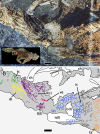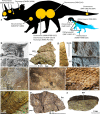The exquisitely preserved integument of Psittacosaurus and the scaly skin of ceratopsian dinosaurs
- PMID: 35962036
- PMCID: PMC9374759
- DOI: 10.1038/s42003-022-03749-3
The exquisitely preserved integument of Psittacosaurus and the scaly skin of ceratopsian dinosaurs
Abstract
The Frankfurt specimen of the early-branching ceratopsian dinosaur Psittacosaurus is remarkable for the exquisite preservation of squamous (scaly) skin and other soft tissues that cover almost its entire body. New observations under Laser-Stimulated Fluorescence (LSF) reveal the complexity of the squamous skin of Psittacosaurus, including several unique features and details of newly detected and previously-described integumentary structures. Variations in the scaly skin are found to be strongly regionalized in Psittacosaurus. For example, feature scales consist of truncated cone-shaped scales on the shoulder, but form a longitudinal row of quadrangular scales on the tail. Re-examined through LSF, the cloaca of Psittacosaurus has a longitudinal opening, or vent; a condition that it shares only with crocodylians. This implies that the cloaca may have had crocodylian-like internal anatomy, including a single, ventrally-positioned copulatory organ. Combined with these new integumentary data, a comprehensive review of integument in ceratopsian dinosaurs reveals that scalation was generally conservative in ceratopsians and typically consisted of large subcircular-to-polygonal feature scales surrounded by a network of smaller non-overlapping polygonal basement scales. This study highlights the importance of combining exceptional specimens with modern imaging techniques, which are helping to redefine the perceived complexity of squamation in ceratopsians and other dinosaurs.
© 2022. The Author(s).
Conflict of interest statement
The authors declare no competing interests.
Figures











References
-
- Mantell, G. A. On the structure of the Iguanodon, and on the fauna and flora of the Wealden Formation. Notice Proceedings, Royal Institute of Great Britain1, 141–146 (1852).
-
- Czerkas, S. A. Skin. in Encyclopedia of Dinosaurs (eds. Currie, P. J. & Padian, K.) 669–675 (Academic Press, 1997).
-
- Czerkas SA. The history and interpretation of sauropod skin impressions. Gaia. 1994;10:173–182.
Publication types
MeSH terms
LinkOut - more resources
Full Text Sources

